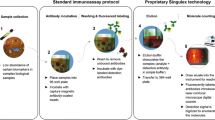Abstract
Following a recently developed concept of MS binding assays based on the quantification of a native marker by LC–MS a procedure to study binding of a low-affinity marker in kinetic, saturation, and competition experiments was established. Separation of bound and unbound marker—the most crucial step of the assay—could be effectively achieved by filtration in a 96-well-format. MS binding assays according to this procedure allowed the reliable characterization of NO 711 binding to mGAT1 in presence of physiological NaCl concentrations. Comparing the results obtained in the present study with those from experiments using 1 mol L−1 NaCl in the incubation milieu reveals remarkable differences with respect to the marker’s affinity and kinetics and to the investigated test compound’s potency.

After incubation of a target with a native marker, bound and unbound marker are separated by filtration. Subsequently, the bound native marker is liberated from the target and finally quantified by LC-MS-MS.





Similar content being viewed by others
References
Williams M, Mehlin C, Triggle DJ (2003) Receptor targets in drug discovery and development. In: Abraham DJ (ed) Burger’s medicinal chemistry and drug discovery, vol 2: Drug development. Wiley, New York
Höfliger MM, Beck-Sickinger AG (2003) Receptor–ligand interaction. In: Böhm HJ, Schneider G (eds) Protein–ligand interactions. From molecular recognition to drug design. Wiley–VCH, Weinheim
Lundqvist T (2005) Curr Opin Drug Discovery Dev 8:513–519
Cooper MA (2004) J Mol Recognit 17:286–315
Siegel MM (2005) Mass-spectrometry-based drug screening assays for early phases in drug discovery. In: Lee MS (ed) Integrated strategies for drug discovery using mass spectrometry. Wiley, New York
Wanner KT, Höfner G (eds) (2007) Mass spectrometry in medicinal chemistry. Wiley–VCH, Weinheim
Höfner G, Wanner KT (2003) Angew Chem Int Ed 42:5235–5237
Höfner G, Wanner KT (2003) Angew Chem 115:5393–5395
Suzdak PD, Frederiksen K, Andersen KE, Sorensen PO, Knutsen LJS, Nielsen EB (1992) Eur J Pharmacol 223:189–198
Armer RE (2000) Curr Med Chem7:199–209
Braestrup C, Nielsen EB, Sonnewald U, Knutsen JS, Andersen KE, Jansen JA, Frederiksen K, Andersen PH, Mortnesen A, Suzdak PD (1990) J Neurochem 54:639–647
Zepperitz C, Höfner G, Wanner KT (2006) Chem Med Chem 1:208–217
Meldrum BS, Chapman AG (1999) Epilepsia 40:2–6
Rovati GE (1998) Trends Pharmacol Sci 19:365–369
Bylund DB, Murrin LC (2000) Life Sci 67:287–291
Bennett JP Jr, Yamamura HI (1985) Neurotransmitter, hormone, or drug receptor binding methods. In: Yamamura HI, Enna SJ, Kuhar MJ (eds) Neurotransmitter receptor binding. Raven Press, New York
Hulme EC (1992) Centrifugation binding assays. In: Hulme EC (ed) Receptor–ligand interactions. A practical approach. IRL Press, Oxford
Cheng Y-C, Prusoff WH (1973) Biochem Pharmacol 22:3099–3108
Kragler A, Höfner G, Wanner KT (2008) Eur J Med Chem, in print
Bradford M (1976) Anal Biochem 72:248–254
Author information
Authors and Affiliations
Corresponding author
Additional information
Dedicated to Prof. Hans-Dietrich Stachel on the occasion of his 80th birthday
Rights and permissions
About this article
Cite this article
Zepperitz, C., Höfner, G. & Wanner, K.T. Expanding the scope of MS binding assays to low-affinity markers as exemplified for mGAT1. Anal Bioanal Chem 391, 309–316 (2008). https://doi.org/10.1007/s00216-008-1956-5
Received:
Revised:
Accepted:
Published:
Issue Date:
DOI: https://doi.org/10.1007/s00216-008-1956-5




